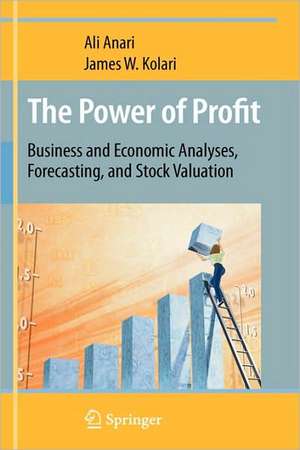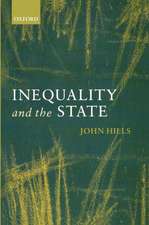The Power of Profit: Business and Economic Analyses, Forecasting, and Stock Valuation
Autor Ali Anari, James W. Kolarien Limba Engleză Hardback – 4 dec 2009
Through rigorous data analysis, the authors show how the profit system modelcan be applied to:
- modeling the U.S. business sector and national economy
- forecasting output, capital stock, total profit, profit rates, and profit margins
- examining the relationships among profitability, economic growth, and the business cycle
- simulating the effects of potential monetary policy changes on the business sector and national economy
- valuing the Standard & Poor’s stock market index as well as individual firms.
| Toate formatele și edițiile | Preț | Express |
|---|---|---|
| Paperback (1) | 635.31 lei 6-8 săpt. | |
| Springer Us – 5 sep 2014 | 635.31 lei 6-8 săpt. | |
| Hardback (1) | 641.53 lei 6-8 săpt. | |
| Springer Us – 4 dec 2009 | 641.53 lei 6-8 săpt. |
Preț: 641.53 lei
Preț vechi: 754.74 lei
-15% Nou
Puncte Express: 962
Preț estimativ în valută:
122.77€ • 127.70$ • 101.36£
122.77€ • 127.70$ • 101.36£
Carte tipărită la comandă
Livrare economică 14-28 aprilie
Preluare comenzi: 021 569.72.76
Specificații
ISBN-13: 9781441906489
ISBN-10: 1441906487
Pagini: 194
Ilustrații: XII, 180 p.
Dimensiuni: 155 x 235 x 20 mm
Greutate: 0.45 kg
Ediția:2010
Editura: Springer Us
Colecția Springer
Locul publicării:New York, NY, United States
ISBN-10: 1441906487
Pagini: 194
Ilustrații: XII, 180 p.
Dimensiuni: 155 x 235 x 20 mm
Greutate: 0.45 kg
Ediția:2010
Editura: Springer Us
Colecția Springer
Locul publicării:New York, NY, United States
Public țintă
ResearchCuprins
The Role of Profit in Advanced Market Economies.- Profit System Models of the Firm, Industry, and Business Sector.- A Macroeconomic Profit System Model of Advanced Market Economies.- Profit System Models of the Corporate Sector.- Profit System Models for Industries.- A Profit System Model of Stock Market Valuation.- A Profit System Model of the Firm for Business Analysis and Stock Valuation.- Concluding Remarks.
Notă biografică
Dr. Ali Anari obtained his PhD in Industrial Economics and Business Studies at the University of Birmingham, United Kingdom in 1978. He has more than 30 years research experience in developing computer-based economic models for economic analysis and forecasting in the areas of energy economics, macroeconomics, real estate economics, and regional economics. In his professional career Dr. Anari has been a research economist in the areas of national and regional economic modeling at the Center for Business and Economic Analysis in the Mays Business School at Texas A&M University, Visiting Scholar in the Anderson School of Management of the University of California, Los Angeles, research economist at the Imperial College of Science and Technology, London, research fellow at the University of Birmingham, U.K., and economic analyst at the economics and statistics department of National Iranian Oil Company. He has presented papers on economic modeling at conferences around the world and published book chapters and articles in such scholarly publications as the Journal of Money, Credit, and Banking, Journal of Applied Economics, Journal of Financial Research, Journal of Real Estate Economics, Journal of Economics and Business, Journal of Energy Policy, and Journal of Emerging Markets. Current research interests include developing economic models for early warning of real estate bubbles, profitability and economic growth, and regional profitability analysis.
Professor James W. Kolari obtained his PhD in Finance at Arizona State University in 1980 and thereafter has taught financial markets and institutions at Texas A&M University in the Finance Department. In 1994 he was awarded the JP Morgan Chase Professorship in Finance in the Mays Business School. Dr. Kolari has more than 30 years research experience in the areas of computer-based modeling of financial markets(including stock, bond, and real estate markets), financial institutions (such as banks and insurance companies), and financial regulation. Over the years, he has been a Visiting Scholar at the Federal Reserve Bank of Chicago, Fulbright Scholar at the University of Helsinki and Bank of Finland, Faculty Fellow with the Mortgage Bankers Association of America, and Senior Research Fellow at the Swedish School of Business and Economics (Hanken) in Finland, in addition to being a consultant to the U.S. Small Business Administration, U.S. Information Agency, American Bankers Association, Independent Bankers Association of America, and numerous banks and other organizations. He has published over 100 articles published in refereed journals, numerous other papers and monographs, and 12 co-authored books. His papers have appeared in such domestic and international journals as the Journal of Finance, Journal of Business, Journal of Money, Credit and Banking, Journal of Economic Dynamics and Control, Journal of Banking and Finance, Real Estate Economics, Journal of International Money and Finance, and Scandanavian Journal of Economics. Papers in Dutch, Finnish, Italian, Swedish, and Russian have appeared outside of the United States. He is a co-author of leading college textbooks in commercial banking and international business courses.
Professor James W. Kolari obtained his PhD in Finance at Arizona State University in 1980 and thereafter has taught financial markets and institutions at Texas A&M University in the Finance Department. In 1994 he was awarded the JP Morgan Chase Professorship in Finance in the Mays Business School. Dr. Kolari has more than 30 years research experience in the areas of computer-based modeling of financial markets(including stock, bond, and real estate markets), financial institutions (such as banks and insurance companies), and financial regulation. Over the years, he has been a Visiting Scholar at the Federal Reserve Bank of Chicago, Fulbright Scholar at the University of Helsinki and Bank of Finland, Faculty Fellow with the Mortgage Bankers Association of America, and Senior Research Fellow at the Swedish School of Business and Economics (Hanken) in Finland, in addition to being a consultant to the U.S. Small Business Administration, U.S. Information Agency, American Bankers Association, Independent Bankers Association of America, and numerous banks and other organizations. He has published over 100 articles published in refereed journals, numerous other papers and monographs, and 12 co-authored books. His papers have appeared in such domestic and international journals as the Journal of Finance, Journal of Business, Journal of Money, Credit and Banking, Journal of Economic Dynamics and Control, Journal of Banking and Finance, Real Estate Economics, Journal of International Money and Finance, and Scandanavian Journal of Economics. Papers in Dutch, Finnish, Italian, Swedish, and Russian have appeared outside of the United States. He is a co-author of leading college textbooks in commercial banking and international business courses.
Textul de pe ultima copertă
How can business leaders make better production and capital investment decisions? How can Wall Street analysts improve their predictions of future stock market values? How can government improve macroeconomic forecasts and policies? In The Power of Profit, Anari and Kolari demonstrate how profit measures can be applied as the basis for these and many other applications of economic, policy, financial, and business analysis. The underlying theme of the book is that profitability is the driving force in free market economies. Firms invest in capital, produce goods and services, and generate sales in an effort to reap profits. Firms that are unprofitable exit the marketplace and are replaced by profitable firms. Despite the crucial importance of profits, however, there is no formal model that directly relates profits to capital formation and output. Previous studies over the past 100 years on profit and the economy are mainly descriptive in nature, without any well-specified model grounded in microeconomic theory. Filling this gap, the authors present a profit system model of the firm grounded in basic accounting relationships in addition to the well-known Cobb-Douglas production function, which can be applied to individual firms, industries, and the business sector as a whole.
Through rigorous data analysis, the authors show how the profit system model
can be applied to:
Through rigorous data analysis, the authors show how the profit system model
can be applied to:
- modeling the U.S. business sector and national economy
- forecasting output, capital stock, total profit, profit rates, and profit margins
- examining the relationships among profitability, economic growth, and the
- simulating the effects of potential monetary policy changes on the business
- valuing the Standard & Poor’s stock market index as well as individual firms
Caracteristici
The first to provide a comprehensive, rigorous, and applied model of profit as an economic driver Both analytical and predictive; can be applied to interpret history and to forecast Principles can be applied to a wide variety of topics, including stock valuation, industry performance, business cycles, strategic management, and effects of monetary policies Authors will supplement the book with on-line tools, including data sets, forecasts, interactive materials, and additional resources Cross-over book, with quantitative and methodological rigor that will appeal to researchers and scholars and practical application that will appeal to business economists, business leaders, bankers, and investors Authors have contacts in the business and policymaking communities Includes supplementary material: sn.pub/extras











